- Always wear a clean uniform.
- A hat and safety shoes must be worn.
| Last Modified: 02-14-2025 | 6.11:8.1.0 | Doc ID: RM100000001514Z |
| Model Year Start: 2018 | Model: Camry HV | Prod Date Range: [07/2017 - 09/2019] |
| Title: INTRODUCTION: REPAIR INSTRUCTION: PRECAUTION; 2018 - 2019 MY Camry HV [07/2017 - 09/2019] | ||
PRECAUTION
BASIC REPAIR HINT
(a) HINTS ON OPERATIONS
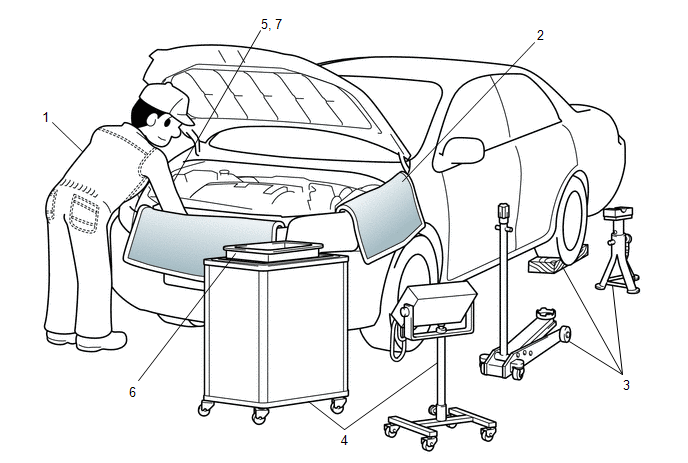
|
1 |
Attire |
|
|
2 |
Vehicle protection |
Prepare a grille cover, fender cover, seat cover and floor mat before starting work. |
|
3 |
Safety procedures |
|
|
4 |
Preparation of tools and measuring equipment |
Before starting work, prepare a tool stand, SST, measuring equipment, oil, and any replacement parts required. |
|
5 |
Removal and installation, disassembly and assembly operations |
|
|
6 |
Removed parts |
|
|
7* |
Checks to perform after work is finished |
|
CAUTION:
*: Be sure to perform these checks properly, not performing these checks properly after finishing work can lead to a serious accident or injury.
(b) JACKING UP AND SUPPORTING THE VEHICLE
(1) Care must be taken when jacking up and supporting the vehicle. Be sure to lift and support the vehicle at the proper locations.
(c) PRECOATED PARTS

|
*a |
Seal Lock Adhesive |
(1) Precoated parts are bolts and nuts that are coated with seal lock adhesive at the factory.
(2) If a precoated part is retightened, loosened or moved in any way, it must be recoated with the specified adhesive.
(3) When reusing a precoated part, clean off the old adhesive and dry the part with compressed air. Then apply new seal lock adhesive appropriately to that part.
(4) Some seal lock agents harden slowly. You may have to wait for the seal lock adhesive to harden.
(d) SMALL-HEAD BOLTS
(1) Small-head bolts are bolts with a smaller bolt head than standard bolts with the same thread diameter and flange diameter.

|
*A |
Example: M6 Bolt |
|
*a |
Ring Mark |
|
*b |
Black |
(2) Although the size of the bolt head is smaller than a standard bolt, the tightening torque remains unchanged as the thread diameter and flange diameter are not different. Make sure to tighten all small-head bolts to the correct torque indicated in the repair manual.
(3) As the force applied to the sides of the head of a small-head bolt is higher than that of a standard bolt when the same tightening torque is used, the height of the bolt head has been increased to ensure its strength.
(4) For identification purposes, small-head bolts are black and the bolt head is marked with a ring.
(e) GASKETS
(1) When necessary, use a sealer on gaskets to prevent leaks.
(f) BOLTS, NUTS AND SCREWS
(1) Carefully follow all of the specifications for tightening torque. Always use a torque wrench.
(2) Make sure that no foreign matter (burrs, paint, etc.) gets trapped under the heads of the bolts and nuts when tightening them.
(g) FUSES
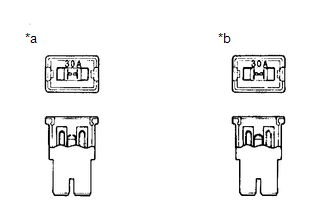
|
*a |
NG |
|
*b |
OK |
(1) When inspecting a fuse, check that the wire of the fuse is not broken.
(2) If the wire of a fuse is broken, confirm that there are no shorts in its circuit.
(3) When a fuse is replaced, a fuse with the same amperage rating must be used.
|
Illustration |
Symbol |
Part Name |
Abbreviation |
|---|---|---|---|

|

|
FUSE |
FUSE |

|

|
MEDIUM CURRENT FUSE |
M-FUSE |

|

|
HIGH CURRENT FUSE |
H-FUSE |

|

|
FUSIBLE LINK |
FL |

|

|
CIRCUIT BREAKER |
CB |

|

|
FUSIBLE LINK |
FL |
(h) CLIPS
(1) The removal and installation methods of typical clips used for vehicle body parts are shown in the table below.
HINT:
If clips are damaged during a procedure, always replace the damaged clips with new ones.
|
Shape (Example) |
Removal/Installation |
|---|---|

|
Remove the clips with a clip remover or pliers. 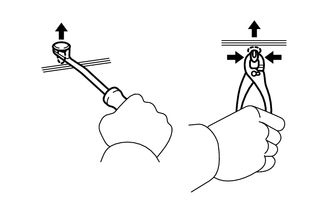
|
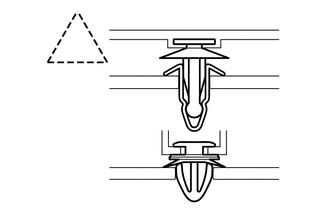
|
Remove the clips using a clip remover or a screwdriver with its tip wrapped with protective tape. 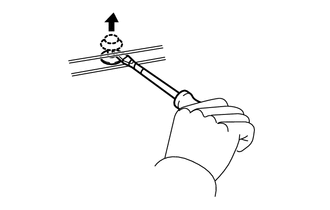
|

|
Remove the clips with a wide scraper to prevent panel damage. 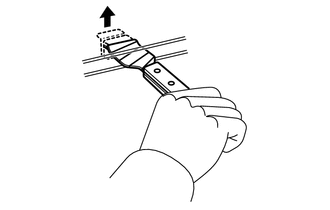
|
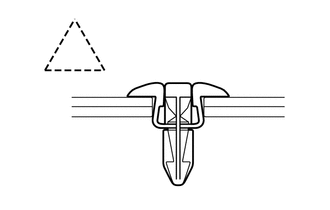
|
Remove the clips by pushing the center pin through and pulling out the shell. 
|
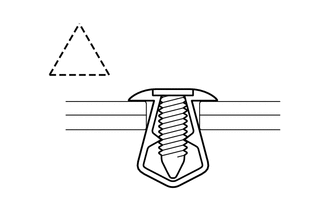
|
Remove the clips by unscrewing the center pin and prying out the shell. 
|
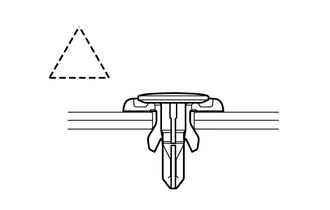
|
Remove the clips by prying out the pin using a screwdriver with its tip wrapped with protective tape and then prying out the shell. 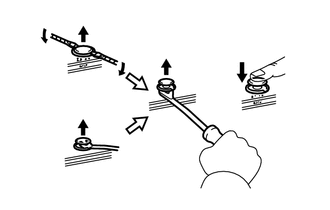
|
(i) CLAWS
(1) The removal and installation methods of typical claws used for vehicle body parts are shown in the table below.
HINT:
If claws are damaged during a procedure, always replace the cap or cover that has damaged claws with a new one.
|
Shape (Example) |
Illustration / Procedures |
|---|---|
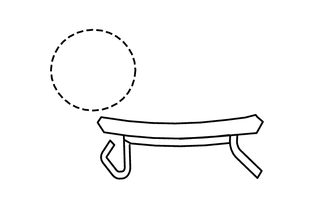
|
Disengage the claws using a screwdriver with its tip wrapped with protective tape to remove the caps or covers. 
|
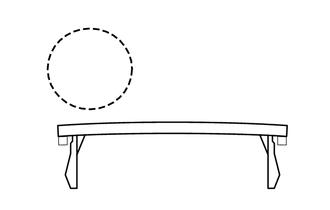
|
Disengage the claws using a screwdriver with its tip wrapped with protective tape to remove the caps or covers. 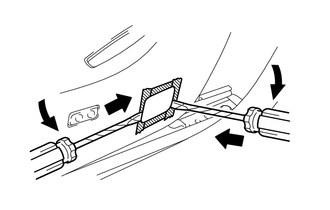
|
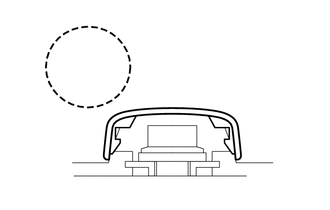
|
Disengage the claws using a screwdriver with its tip wrapped with protective tape to remove the caps or covers. 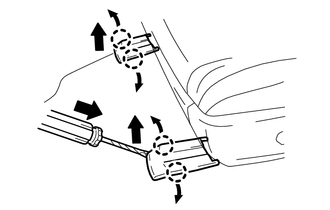
|
(j) HINGES, GUIDES, CLAMPS, PINS, ETC.
(1) The removal and installation methods of typical hinges, guides, clamps and pins used for vehicle body parts are shown in the table below.
HINT:
If clamps are damaged during a procedure, always replace the cap or cover that has damaged clamps with a new one.
|
Shape (Example) |
Removal/Installation |
|---|---|

|
Pull away from the pins to disengage. 
|
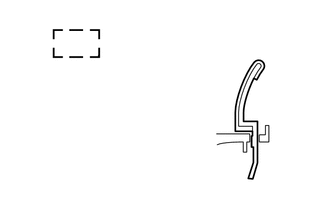
|
Disengage the pins by pulling. 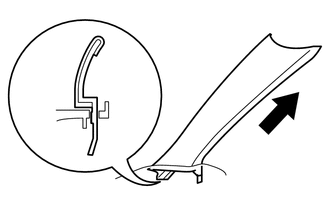
|
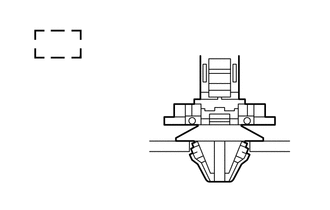
|
Remove the clamps with pliers. 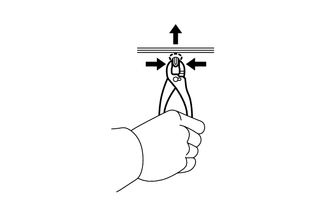
|

|
Disengage the pins by pulling. 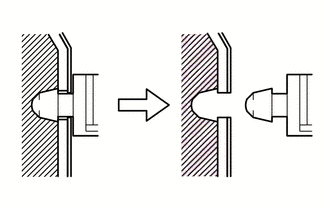
|
(k) REMOVAL AND INSTALLATION OF VACUUM HOSES
(1) To disconnect a vacuum hose, pull and twist it from the end of the hose. Do not pull it from the middle of the hose as this may damage the hose.
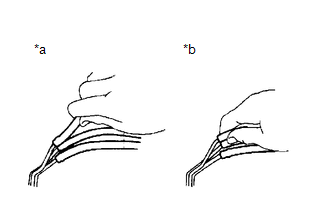
|
*a |
Incorrect |
|
*b |
Correct |
(2) When disconnecting vacuum hoses, use tags to identify where they should be reconnected.
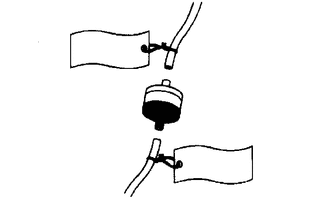
(3) After completing any hose related repairs, double-check that the vacuum hoses are properly connected. The label under the hood shows the proper layout.
(4) When using a vacuum gauge, never force the hose onto a connector that is too large. If a hose has been stretched, air may leak. Use a step-down adapter if necessary.
(l) TORQUE WHEN USING TORQUE WRENCH WITH EXTENSION TOOL
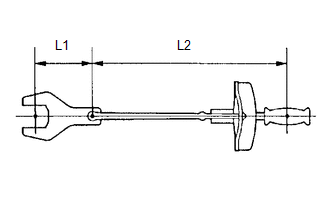
(1) Use the formula below to calculate special torque values for situations where SST or an extension tool is combined with a torque wrench.
Formula:
T' = (L2/(L1 + L2))*T
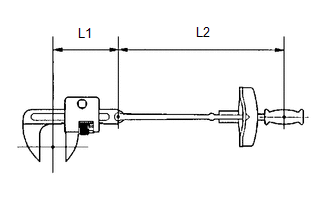
|
T' |
Reading of torque wrench (N*m (kgf*cm, ft.*lbf)) |
|
T |
Torque (N*m (kgf*cm, ft.*lbf)) |
|
L1 |
Length of SST or extension tool (cm (in.)) |
|
L2 |
Length of torque wrench (cm (in.)) |
NOTICE:
If an extension tool or SST is combined with a torque wrench and used to tighten to a torque specification in this manual, the actual torque will be excessive and parts will be damaged.
PRECAUTIONS FOR HIGH-VOLTAGE CIRCUIT INSPECTION AND SERVICE
CAUTION:
- This vehicle has a hybrid system that operates at voltages up to 650 V. The hybrid system uses an HV battery that contains an electrolyte which is a strong alkali solution that includes potassium hydroxide. Be sure to follow the instructions in this manual to handle the system correctly. Failure to do so may result in serious injury or electrocution. (for Nickel Metal Hydride Battery)
- This vehicle has a hybrid system that operates at voltages of up to 650 V. An organic electrolyte containing carbonic acid esters as its main component is used as the electrolyte for the HV battery. Be sure to follow the instructions in this manual to handle the system correctly. Failure to do so may result in serious injury or electrocution. (for Lithium-ion Battery)
(a) Technicians must undergo special training to be able to service and inspect the high-voltage system.
(b) All high-voltage wire harnesses and connectors are colored orange. The HV battery and other high-voltage components have "High Voltage" caution labels. Do not carelessly touch these wires or components.
(c) When there is a problem with a wire harness or connector of a high-voltage circuit, repairs to the harness or connector should not be attempted. Replace damaged or malfunctioning high-voltage wire or connector.
(d) Before inspecting or servicing the high-voltage system, be sure to follow all safety measures, such as wearing insulated gloves and removing the service plug grip to prevent electrocution. Carry the removed service plug grip in your pocket to prevent other technicians from accidentally reconnecting it while you are servicing the vehicle.
NOTICE:
After removing the service plug grip, do not turn the power switch on (READY), unless instructed by the repair manual, as this may cause a malfunction.
(e) After removing the service plug grip, wait 10 minutes before touching any of the high-voltage connectors and terminals.
HINT:
Waiting for at least 10 minutes is required to discharge the high-voltage capacitor inside the inverter with converter assembly.
(f) Before using insulated gloves, be sure to check them for cracks, tears and other types of damage by performing the following procedure.
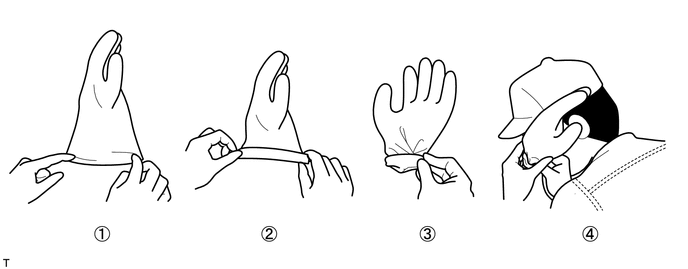
- Place the glove on its side.
- Roll the opening up 2 or 3 times.
- Fold the opening in half to close it.
- Confirm that there are no air leaks.
(g) When servicing the vehicle, do not carry metal objects like mechanical pencils or rulers that can be dropped accidentally and cause a short circuit.
(h) Before touching a bare high-voltage terminal, wear insulated gloves and use a tester to make sure that the terminal voltage is 0 V.
(i) After disconnecting or exposing a high-voltage connector or terminal, insulate it immediately using insulating tape.

(j) Bolts and nuts for high-voltage terminals should be tightened to the specified torque. Both insufficient and excessive torque can cause a malfunction.
(k) Use the "CAUTION: HIGH VOLTAGE DO NOT TOUCH" sign to notify other technicians that the high-voltage system is being inspected and/or repaired.
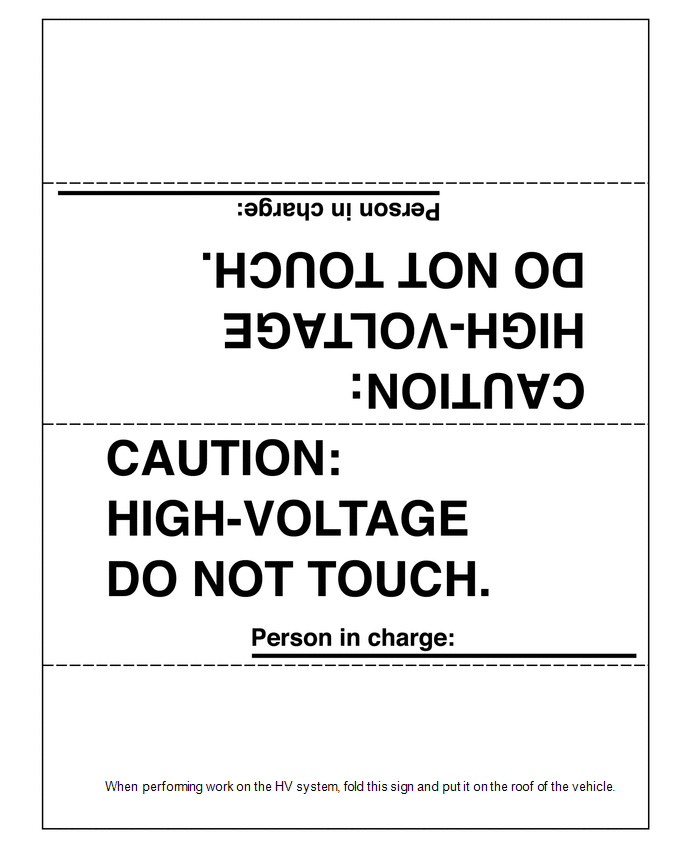
(l) After servicing the high-voltage system and before reinstalling the service plug grip, check again that you have not left any parts or tools inside, that the high-voltage terminals are firmly tightened, and that the connectors are correctly connected.
(m) When performing work involving a high-voltage circuit, use either a tool wrapped with vinyl insulation tape or an insulated tool.
(n) When installing hybrid system components such as the HV battery, make sure that the polarity of all connections is correct.
PRECAUTIONS TO BE OBSERVED WHEN INSPECTING OR SERVICING ENGINE COMPARTMENT
(a) The vehicle automatically turns the engine on and off when the READY light on the combination meter assembly is illuminated. To avoid injury, make sure that both the indicator on the power switch and the READY light on the combination meter assembly are off.
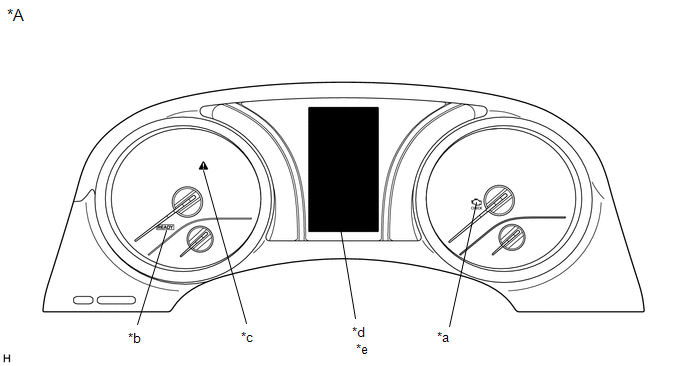
|
*A |
for 4.2-inch Display Type |
- |
- |
|
*a |
MIL |
*b |
READY Light |
|
*c |
Master Warning Light |
*d |
Multi-information Display |
|
*e |
Charge Warning |
- |
- |

|
*A |
for 7-inch Display Type |
- |
- |
|
*a |
MIL |
*b |
READY Light |
|
*c |
Master Warning Light |
*d |
Multi-information Display |
|
*e |
Charge Warning |
- |
- |
ACTIONS TO BE TAKEN WHEN A WARNING LIGHT IS ILLUMINATED
(a) If one of the warning lights (2) to (4) illuminates, connect the Techstream to the DLC3 and check for DTCs (Diagnostic Trouble Codes). Refer to the respective troubleshooting procedures in this manual for the output DTCs to inspect and repair the affected area. It is also necessary to check for DTCs if the READY light does not illuminate when attempting to turn the power switch on (READY).
|
Indicator Light |
Vehicle Condition |
|---|---|
|
(1) READY Light (To Drive) |
Illuminates when the power switch is turned on (READY), indicating that the vehicle is ready to be driven. |
|
(2) Master Warning Light |
Depending on the warning, the master warning light illuminates or flashes to indicate that a warning is currently being displayed on the multi-information display. Depending on the warning, the buzzer may also sound. When any malfunction occurs in the hybrid control system or hybrid battery system, the master warning light illuminates or flashes along with a buzzer, and a warning, such as, "Hybrid System Malfunction", is displayed on the multi-information display. |
|
(3) MIL |
Illuminates when there is a malfunction in the engine control system. |
|
(4) Charge Warning |
Displayed when there is a malfunction in the charging system. (Be sure to check for DTCs (Diagnostic Trouble Codes) if this message displayed when the master warning light is illuminated.) |
ACTIONS TO BE TAKEN WHEN BATTERIES ARE DISCHARGED
HINT:
This vehicle uses an auxiliary battery and an HV battery. Therefore, there are 2 recharging methods when the batteries are discharged.
(a) Perform this procedure when the auxiliary battery is discharged.
NOTICE:
- Never use a quick charger.
- The booster terminal can only be used to rescue this vehicle and cannot be used to rescue another vehicle with a discharged battery.
HINT:
The following problems indicate that the auxiliary battery is discharged:
- No display appears on the instrument panel when the power switch is turned on (IG).
- The hybrid system does not start.
- The headlights are dim.
- The sound from the horn is weak.
(1) Engage the parking brake.
(2) Turn the power switch off and remove the key from the interior detection area.
(3) Remove the No. 1 engine room relay block and No. 1 junction block assembly cover.
(4) Using booster cables, connect the 12 V auxiliary battery of the rescue vehicle to the auxiliary battery of the stalled vehicle as shown in the illustration.
HINT:
Use the booster terminal in the engine compartment.
|
Connecting Sequence |
Connecting Location |
|---|---|
|
1 |
Booster terminal of stalled vehicle |
|
2 |
Positive (+) auxiliary battery terminal of rescue vehicle |
|
3 |
Negative (-) auxiliary battery terminal of rescue vehicle |
|
4 |
Position shown in the illustration on stalled vehicle |
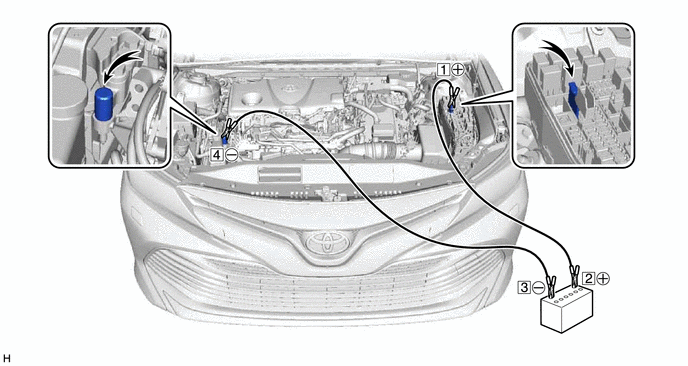
(5) Start the engine of the rescue vehicle and run the engine at a speed slightly higher than usual.
(6) Turn the power switch on (READY).
NOTICE:
Immediately disconnect the booster cables in the reverse order of connection after the hybrid system has started. Do not leave the booster cables connected because they are not designed for recharging purposes.
If the hybrid system fails to start and "Traction Battery Needs to be Protected Refrain From the Use of N Position" or "Traction Battery Needs to be Protected Shift into P to Restart" is displayed on the multi-information display, the HV battery may be discharged.
(b) When the HV battery is discharged:
(1) Using the THS charger, charge the HV battery.
HINT:
Perform this operation only when the HV battery is discharged or low, or if a low traction battery warning message is displayed on the multi-information display and DTC P300000 or P300016 is stored in the hybrid vehicle control ECU assembly or battery ECU assembly.
ACTIONS TO BE TAKEN FOR VEHICLES DAMAGED BY IMPACT (for NICKEL METAL HYDRIDE BATTERY)
CAUTION:
This vehicle has a hybrid system that operates at voltages up to 650 V. The hybrid system uses an HV battery that contains an electrolyte which is a strong alkali solution that includes potassium hydroxide. Be sure to follow the instructions in this manual to handle the system correctly. Failure to do so may result in serious injury or electrocution.
(a) Items to be prepared for the accident site
- Protective clothing (insulated gloves, rubber gloves, goggles and safety shoes)
- 20 liters (21.1 US qts, 17.6 Imp. qts) saturated boric acid solution (obtain 800 g (1.76 lb) of boric acid powder, put it into a container, and dissolve it in water)
- Red litmus paper
- ABC fire extinguisher (effective against both oil flames and electrical flames)
- A shop rag or piece of cloth (for wiping up the neutralized electrolyte)
- Insulating tape (for insulating cables)
- Electrical tester
(b) Actions to be taken at the accident site
CAUTION:
- Do not touch any bare cables that could be high-voltage cables. If a cable must be touched or if accidental contact is possible, wear insulated gloves and insulate the cable using insulating tape.
- If the vehicle catches on fire, use an ABC fire extinguisher to extinguish the fire. Trying to extinguish a fire using only a small amount of water can be more dangerous than effective. Use a substantial amount of water or wait for firefighters.
- Visually check the HV battery and the surrounding area for any electrolyte leakage. Do not touch any leaked liquid because it could be highly alkaline electrolyte.
- If the vehicle is submerged in water, work on the vehicle only after the vehicle has been pulled out of the water.
(1) Check the vicinity of the HV battery for any leakage of the electrolyte.
CAUTION:
- Do not touch any leaked liquid because it could be highly alkaline electrolyte. Wearing rubber gloves and goggles, neutralize the liquid with saturated boric acid solution and then apply red litmus paper to the liquid. Check that the paper does not turn blue. Wipe up the neutralized electrolyte with a shop rag or piece of cloth.
- If the electrolyte comes in contact with your skin, use a saturated boric acid solution or a large amount of water to wash it off. If the electrolyte comes in contact with an article of clothing, take it off immediately.
- If the electrolyte comes in contact with your eyes, call out loudly for help. Do not rub your eyes. Wash them immediately with a large amount of water and seek medical care.
- If electrolyte is swallowed, seek medical care immediately. Do not induce vomiting, unless instructed by the doctor.
(2) If damage to any of the high-voltage components and cables is suspected, cut the high-voltage circuit using the following procedure.
CAUTION:
Be sure to wear insulated gloves, goggles and safety shoes.

|
*1 |
NO. 1 ENGINE ROOM RELAY BLOCK AND NO. 1 JUNCTION BLOCK ASSEMBLY |
*2 |
INVERTER WITH CONVERTER ASSEMBLY |
|
*3 |
COMPRESSOR WITH MOTOR ASSEMBLY |
*4 |
HYBRID VEHICLE TRANSAXLE ASSEMBLY |
|
*5 |
HV BATTERY |
*6 |
HV FLOOR UNDER WIRE |
|
*7 |
AUXILIARY BATTERY |
- |
- |
(3) Turn the power switch off.
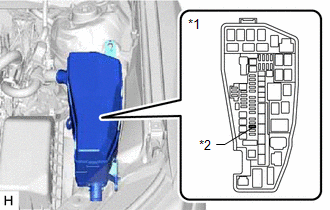
|
*1 |
No. 1 Engine Room Relay Block And No. 1 Junction Block Assembly |
|
*2 |
IG2-MAIN Fuse |
HINT:
If the power switch cannot be turned off, remove the IG2-MAIN fuse from the No. 1 engine room relay block and No. 1 junction block assembly. Then confirm that the READY light is not illuminated.
(4) Disconnect the cable from the negative (-) auxiliary battery terminal.
(5) While wearing insulated gloves, remove the service plug grip.
NOTICE:
After removing the service plug grip, do not turn the power switch on (READY), unless instructed by the repair manual because this may cause a malfunction.
(c) Moving the damaged vehicle
NOTICE:
When towing the vehicle, refer to Precautions for Towing Front Wheel Drive Vehicles.
If any of the following conditions are met, tow the vehicle using a tow truck.
- One or more of the high-voltage components and cables are damaged.
- Components related to driving, the hybrid transaxle or the fuel system are damaged.
- The master warning light is on.
- The READY light does not come on when attempting to turn the power switch on (READY).
CAUTION:
Before towing the vehicle using a tow truck, disconnect the cable from the negative (-) auxiliary battery terminal and remove the service plug grip.
NOTICE:
Perform the procedure below if the master warning light turns on, or there are abnormal noises, unusual smells or strong vibrations while driving:
(1) Park the vehicle in a safe place.
(2) Apply the parking brake, and then move the shift lever to P.
(3) Turn the power switch off, and disconnect the cable from the negative (-) auxiliary battery terminal.
(4) While wearing insulated gloves remove the service plug grip.
(d) Actions required after moving the damaged vehicle
(1) Procedure
If you see any liquid on the road surface, it could be highly alkaline electrolyte.
Wearing rubber gloves and goggles, neutralize the electrolyte with saturated boric acid solution, and then apply red litmus paper to the liquid. Check that the paper does not turn blue. Wipe up the neutralized liquid with a shop rag or piece of cloth.
(e) Items to be prepared (when repairing a damaged vehicle)
- Protective clothing (insulated gloves, rubber gloves, goggles and safety shoes)
- 20 liters (21.1 US qts, 17.6 Imp. qts) saturated boric acid solution (obtain 800 g (1.76 lb) of boric acid powder, put it into a container, and dissolve it in water)
- Red litmus paper
- A shop rag or piece of cloth (for wiping up the neutralized electrolyte)
- Insulating tape (for insulating cables)
- Electrical tester
(f) Precautions to be observed when servicing a damaged vehicle
CAUTION:
Always follow instructions to ensure safety.
(1) Wear insulated or rubber gloves, goggles, and safety shoes.
(2) Check the HV battery and immediate area for any electrolyte leakage.
CAUTION:
- Do not touch any bare cables that could be high-voltage cables. If a cable must be touched or if accidental contact is possible, wear insulated gloves and insulate the cable using insulating tape.
- Do not touch any leaked liquid because it could be highly alkaline electrolyte. Wearing rubber gloves and goggles, neutralize the liquid with saturated boric acid solution and then apply red litmus paper to the liquid. Check that the paper does not turn blue. Wipe up the neutralized electrolyte with a shop rag or piece of cloth.
- If the electrolyte comes in contact with your skin, use a saturated boric acid solution or a large amount of water to wash it off. If the electrolyte comes in contact with an article of clothing, take it off immediately.
- If the electrolyte comes in contact with your eyes, call out loudly for help. Do not rub your eyes. Wash them immediately with a large amount of water and seek medical care.
- If electrolyte is swallowed, seek medical care immediately. Do not induce vomiting, unless instructed by the doctor.
(3) Do not touch any bare cables that could be high-voltage cables. If a cable must be touched or if accidental contact is possible, follow the following instructions: 1) wear insulated gloves and goggles, 2) measure the voltage between the cable and body ground using an electrical tester, and 3) insulate the cable using insulating tape.
(4) If damage to any of the high-voltage components and cables is suspected, cut the high-voltage circuit using the procedure below.
CAUTION:
Do not touch any bare cables that could be high-voltage cables. If a cable must be touched or if accidental contact is possible, wear insulated gloves and insulate the cable using insulating tape.
(5) Turn the power switch off.
HINT:
If the power switch cannot be turned off, remove the IG2-MAIN fuse from the No. 1 engine room relay block and No. 1 junction block assembly. Then confirm that the READY light is not illuminated.

|
*1 |
No. 1 Engine Room Relay Block And No. 1 Junction Block Assembly |
|
*2 |
IG2-MAIN Fuse |
(6) Disconnect the cable from the negative (-) auxiliary battery terminal.
(7) While wearing insulated gloves, remove the service plug grip.
NOTICE:
After removing the service plug grip, do not turn the power switch on (READY), unless instructed by the repair manual because this may cause a malfunction.
(g) Precautions to be taken when disposing of an HV battery
(1) When disposing of an HV battery, make sure to return it through an authorized collection agent who is capable of handling it safely. If the HV battery is returned via the manufacturer specified route, it will be returned properly and in a safe manner by an authorized collection agent.
CAUTION:
- Accidents such as electric shock may result if the HV battery is disposed of improperly or abandoned. Therefore, make sure to return all HV batteries through an authorized collection agent.
- After removing the HV battery, keep it away from water. Exposure to water may cause the HV battery to produce heat, resulting in a fire.
(h) Precautions to be observed when towing
(1) Tow the damaged vehicle with its front and rear wheels lifted off the ground.
CAUTION:
Towing the damaged vehicle with its wheels on the ground will cause the motor to generate electricity. This electricity could, depending on the nature of the damage, leak and cause a fire.
(i) Towing with all 4 wheels on the ground
CAUTION:
- If the vehicle needs to be towed using a cable or chain with all 4 wheels on the ground, do not exceed 30 km/h (18 mph) and tow only for a short distance and then have the vehicle towed by a truck.
- Make sure to turn the power switch on (IG), and move the shift lever to N.
- Do not turn off the power switch. Turning off the power switch may result in engagement of the steering lock, resulting in a hazardous situation or accident.
- If any abnormality in the damaged vehicle is present occurs during towing, stop towing immediately.
ACTIONS TO BE TAKEN FOR VEHICLES DAMAGED BY IMPACT (for LITHIUM-ION BATTERY)
CAUTION:
This vehicle has a hybrid system that operates at voltages of up to 650 V. An organic electrolyte containing carbonic acid esters as its main component is used as the electrolyte for the HV battery. Be sure to follow the instructions in this manual to handle the system correctly. Failure to do so may result in serious injury or electrocution.
(a) Items to be prepared for the accident site
- Protective clothing (insulated gloves, rubber gloves, goggles, organic solvent mask, safety shoes and solvent resistant apron (for organic solvent))
- Soap
- ABC fire extinguisher (effective against both oil flames and electrical flames)
- A shop rag or piece of cloth (for wiping up electrolyte)
- Insulating tape (for insulating cables)
- Electrical tester
(b) Actions to be taken at the accident site
CAUTION:
- Do not touch any bare cables that could be high-voltage cables. If a cable must be touched or if accidental contact is possible, wear insulated gloves and insulate the cable using insulating tape.
- If the vehicle catches on fire, use an ABC fire extinguisher to extinguish the fire. Trying to extinguish a fire using only a small amount of water can be more dangerous than effective. Use a substantial amount of water or wait for firefighters.
- Visually check the HV battery and surrounding area for any electrolyte leakage. Do not touch any leaked liquid because it could be organic electrolyte that contains carbonic acid esters.
- The electrolyte is flammable. Keep all ignition sources such as open flame and hot objects away from the electrolyte.
- Electrolyte leaks may cause acute poisoning if a high concentration of the vapor from the electrolyte is inhaled. In case of inhalation, move the affected person to a place with ample fresh air and let them lie quietly. Seek medical care.
- If the vehicle is submerged in water, do not touch any of the high-voltage components or cables including the service plug grip, as doing so poses an electrocution hazard. Work on the vehicle only after the vehicle has been pulled out of the water.
- If the electrolyte comes in contact with your skin, wash the area thoroughly with soap and plenty of water, and seek medical care. If the electrolyte comes in contact with an article of clothing, take it off immediately. Prolonged contact with the electrolyte may cause skin irritation.
- If the electrolyte comes in contact with your eyes, call out loudly for help. Do not rub your eyes. Immediately flush them with a large amount of water for at least 15 minutes and seek medical care.
- If electrolyte is swallowed, seek medical care immediately. Do not induce vomiting, unless instructed by the doctor.
(1) Check the vicinity of the HV battery for any leakage of the electrolyte.
CAUTION:
Do not touch any leaked liquid because it could be organic electrolyte that contains carbonic acid esters. If contact is unavoidable, wipe up the liquid using a cloth while wearing rubber gloves, goggles and an organic solvent mask. Do not leave electrolyte-contaminated cloths unattended. Place contaminated cloths in an appropriate airtight container and dispose of them according to local regulations.
(2) If damage to any of the high-voltage components or cables is suspected, cut the high-voltage circuit using the following procedure.
CAUTION:
Be sure to wear insulated gloves, goggles and safety shoes.
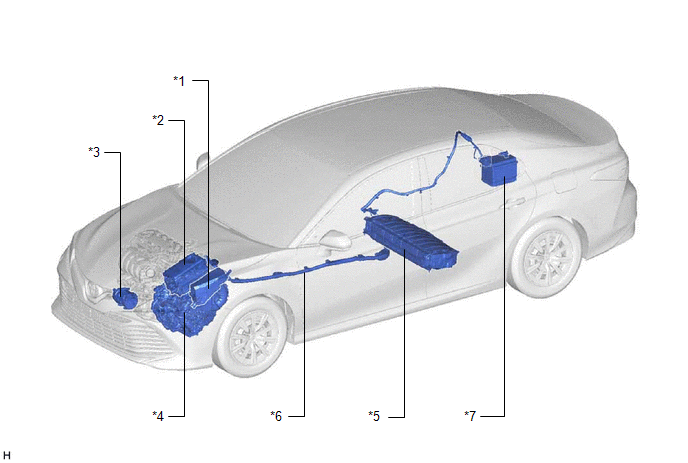
|
*1 |
NO. 1 ENGINE ROOM RELAY BLOCK AND NO. 1 JUNCTION BLOCK ASSEMBLY |
*2 |
INVERTER WITH CONVERTER ASSEMBLY |
|
*3 |
COMPRESSOR WITH MOTOR ASSEMBLY |
*4 |
HYBRID VEHICLE TRANSAXLE ASSEMBLY |
|
*5 |
HV BATTERY |
*6 |
HV FLOOR UNDER WIRE |
|
*7 |
AUXILIARY BATTERY |
- |
- |
(3) Turn the power switch off.

|
*1 |
No. 1 Engine Room Relay Block and No. 1 Junction Block Assembly |
|
*2 |
IG2-MAIN Fuse |
HINT:
If the power switch cannot be turned off, remove the IG2-MAIN fuse from the No. 1 engine room relay block and No. 1 junction block assembly. Then confirm that the READY light is not illuminated.
(4) Disconnect the cable from the negative (-) auxiliary battery terminal.
(5) While wearing insulated gloves, remove the service plug grip.
NOTICE:
After removing the service plug grip, do not turn the power switch on (READY), unless instructed by the repair manual because this may cause a malfunction.
(c) Moving the damaged vehicle
NOTICE:
When towing the vehicle, refer to the Precautions for Towing Front Wheel Drive Vehicles.
If any of the following conditions are met, tow the vehicle using a tow truck.
- One or more of the high-voltage components and cables are damaged.
- Components related to driving, the hybrid transaxle or the fuel system are damaged.
- The master warning light is on.
- The READY light does not come on when attempting to turn the power switch on (READY).
CAUTION:
Before towing the vehicle using a tow truck, disconnect the cable from the negative (-) auxiliary battery terminal and remove the service plug grip.
NOTICE:
Perform the procedure below if the master warning light turns on, or there are abnormal noises, unusual smells or strong vibrations while driving:
(1) Park the vehicle in a safe place.
(2) Apply the parking brake, and then move the shift lever to P.
(3) Turn the power switch off, and disconnect the cable from the negative (-) auxiliary battery terminal.
(4) While wearing insulated gloves remove the service plug grip.
(d) Actions required after moving the damaged vehicle
(1) Procedure
If there is liquid on the floor, it could be organic electrolyte containing carbonic acid esters. Wipe up the liquid using a cloth while wearing rubber gloves, goggles and an organic solvent mask. Do not leave electrolyte-contaminated cloths unattended. Place contaminated cloths in an appropriate airtight container and dispose of them according to local regulations.
(e) Items to be prepared (when repairing a damaged vehicle)
- Protective clothing (insulated gloves, rubber gloves, goggles, organic solvent mask, safety shoes and solvent resistant apron (for organic solvent))
- Soap
- ABC fire extinguisher (effective against both oil flames and electrical flames)
- A shop rag or piece of cloth (for wiping up electrolyte)
- Insulating tape (for insulating cables)
- Electrical tester
(f) Precautions to be observed when servicing a damaged vehicle
CAUTION:
- Always follow the instructions to ensure safety.
- Do not touch any bare cables that could be high-voltage cables. If a cable must be touched or if accidental contact is possible, wear insulated gloves and insulate the cable using insulating tape.
- Visually check the HV battery and surrounding area for any electrolyte leakage. Do not touch any leaked liquid because it could be organic electrolyte that contains carbonic acid esters.
- The electrolyte is flammable. Keep all ignition sources such as open flame and hot objects away from the electrolyte.
- Electrolyte leaks may cause acute poisoning if a high concentration of the vapor from the electrolyte is inhaled. In case of inhalation, move the affected person to a place with ample fresh air and let them lie quietly. Seek medical care.
- If the electrolyte comes in contact with your skin, wash the area thoroughly with soap and plenty of water, and seek medical care. If the electrolyte comes in contact with an article of clothing, take it off immediately. Prolonged contact with the electrolyte may cause skin irritation.
- If the electrolyte comes in contact with your eyes, call out loudly for help. Do not rub your eyes. Immediately flush them with a large amount of water for at least 15 minutes and seek medical care.
- If electrolyte is swallowed, seek medical care immediately. Do not induce vomiting, unless instructed by the doctor.
(1) Wear insulated or rubber gloves, goggles, and safety shoes.
(2) Check the HV battery and surrounding area for any electrolyte leakage.
CAUTION:
Do not touch any leaked liquid because it could be the organic electrolyte that contains carbonic acid esters. If contact is unavoidable, wipe up the liquid using a cloth while wearing rubber gloves, goggles and an organic solvent mask. Do not leave electrolyte-contaminated cloths unattended. Place contaminated cloths in an appropriate airtight container and dispose of them according to local regulations.
(3) Do not touch any bare cables that could be high-voltage cables. If a cable must be touched or if accidental contact is possible, perform the following: 1) wear insulated gloves and goggles, 2) measure the voltage between the cable and body ground using an electrical tester, and 3) insulate the cable using insulating tape.
(4) If damage to any of the high-voltage components and cables is suspected, cut the high-voltage circuit using the procedure below.
CAUTION:
Do not touch any bare cables that could be high-voltage cables. If a cable must be touched or if accidental contact is possible, wear insulated gloves and insulate the cable using insulating tape.
(5) Turn the power switch off.
HINT:
If the power switch cannot be turned off, remove the IG2-MAIN fuse from the No. 1 engine room relay block and No. 1 junction block assembly. Then confirm that the READY light is not illuminated.

|
*1 |
No. 1 Engine Room Relay Block and No. 1 Junction Block Assembly |
|
*2 |
IG2-MAIN Fuse |
(6) Disconnect the cable from the negative (-) auxiliary battery terminal.
(7) While wearing insulated gloves, remove the service plug grip.
NOTICE:
After removing the service plug grip, do not turn the power switch on (READY), unless instructed by the repair manual because this may cause a malfunction.
(g) Precautions to be taken when disposing of an HV battery
(1) When disposing of an HV battery, make sure to return it through an authorized collection agent who is capable of handling it safely. If the HV battery is returned via the manufacturer specified route, it will be returned properly and in a safe manner by an authorized collection agent.
CAUTION:
- Before returning the HV battery, make sure to perform Recovery Inspection.
- Accidents such as electric shock may result if the HV battery is disposed of improperly or abandoned. Therefore, make sure to return all HV batteries through an authorized collection agent.
- To reduce the risk of fire, the HV battery must not be stored in an area where it will be exposed to open flame or high temperatures.
(h) Precautions to be observed when towing
(1) Tow the damaged vehicle with its front and rear wheels lifted off the ground.
CAUTION:
Towing the damaged vehicle with its wheels on the ground will cause the motor to generate electricity. This electricity could, depending on the nature of the damage, leak and cause a fire.
(i) Towing with all 4 wheels on the ground
CAUTION:
- If the vehicle needs to be towed using a cable or chain with all 4 wheels on the ground, do not exceed 30 km/h (18 mph) and tow only for a short distance and then have the vehicle towed by a truck.
- Make sure to turn the power switch on (IG), and move the shift lever to N.
- Do not turn off the power switch. Turning off the power switch may result in engagement of the steering lock, resulting in a hazardous situation or accident.
- If any abnormality in the damaged vehicle is present occurs during towing, stop towing immediately.
FOR VEHICLES EQUIPPED WITH SRS AIRBAG AND SEAT BELT PRETENSIONER
This vehicle is equipped with a Supplemental Restraint System (SRS).
CAUTION:
- Before performing pre-disposal deployment of any SRS parts, review and closely follow all applicable environmental and hazardous material regulations. Pre-disposal deployment may be considered hazardous material treatment.
- Failure to carry out the service operations in the correct sequence could cause the SRS to unexpectedly deploy during servicing and lead to a serious injury. Furthermore, if a mistake is made when servicing the SRS, it is possible that the SRS may fail to operate properly. Before servicing (including removal or installation of parts, inspection or replacement), be sure to read the following section carefully.
(a) GENERAL NOTICE
(1) As malfunctions of the SRS are difficult to confirm, Diagnostic Trouble Codes (DTCs) become the most important source of information when troubleshooting. When troubleshooting the SRS, always check for DTCs before disconnecting the auxiliary battery.
(2) Work must be started at least 90 seconds after the power switch is turned off and the cable is disconnected from the negative (-) auxiliary battery terminal.
The SRS is equipped with a back-up power source. If work is started within 90 seconds of turning the power switch off and disconnecting the cable from the negative (-) auxiliary battery terminal, the SRS may deploy.
When the cable is disconnected from the negative (-) auxiliary battery terminal, the clock and audio system memory will be cleared. Before starting work, make a note of the settings of each memory system. When work is finished, reset the clock and audio system as before.
CAUTION:
Never use a back-up power source (auxiliary battery or other) to avoid clearing the system memory. The back-up power source may inadvertently power the SRS and cause it to deploy.
(3) If the vehicle has been involved in a minor collision where the SRS does not deploy, the steering pad, front passenger airbag assembly, knee airbag assembly, SRS seat cushion airbag assembly, seat side airbag assemblies, curtain shield airbag assemblies and seat outer belt assemblies should be inspected before further use of the vehicle.
(4) Never use SRS parts from another vehicle. When replacing parts, use new ones.
(5) Before performing repairs, remove the airbag sensor assemblies if impacts are likely to be applied to the sensor during repairs.
(6) Never disassemble and attempt to repair any of the airbag sensor assemblies or SRS parts.
- Steering pad
- Front passenger airbag assembly
- Knee airbag assembly
- Seat side airbag assembly
- Curtain shield airbag assembly
- Seat outer belt assembly
(7) Replace any airbag sensor assembly or SRS parts if: 1) damage has occurred from being dropped, or 2) cracks, dents or other defects in the case, bracket or connector are present.
(8) Do not directly expose the airbag sensor assemblies or SRS parts to hot air or flames.
(9) Use a voltmeter/ohmmeter with high impedance (minimum = 10 kΩ) for troubleshooting electrical circuits.
(10) Information labels are attached to the SRS parts. Follow the instructions on the labels.
(11) After work on the SRS is completed, check the SRS warning light.
(b) SPIRAL CABLE
(1) The steering wheel must be fitted correctly to the steering column with the spiral cable at the neutral position. Otherwise, cable damage and other problems may occur. Refer to the information about correct installation of the steering wheel.
(c) STEERING PAD
(1) Always place a removed or new steering pad with the deployment surface facing upward. Placing the steering pad with the deployment surface facing downward could cause a serious accident if the airbag deploys. Also, do not place anything on top of the steering pad.
(2) Never measure the resistance of the airbag squib. This may cause the airbag to deploy, which could cause serious injury.
(3) Grease or detergents of any kind should not be applied to the steering pad.
(4) Store the steering pad in an area where the ambient temperature is below 93°C (199°F), the humidity is not high and there is no electrical noise.
(5) Before using an electric welder anywhere on the vehicle, disconnect the center airbag sensor assembly connectors. These connectors contain shorting springs. This feature reduces the possibility of the airbag deploying due to current entering the squib wiring.
(6) When disposing of the vehicle or steering pad by itself, the airbag should be deployed using SST before disposal. Deploy the airbag in a safe place away from electrical noise.
(d) FRONT PASSENGER AIRBAG ASSEMBLY
(1) Always place a removed or new front passenger airbag assembly with the deployment surface facing upward. Placing the airbag assembly with the airbag deployment surface facing downward could cause a serious accident if the airbag deploys.
(2) Never measure the resistance of the airbag squib. This may cause the airbag to deploy, which could cause serious injury.
(3) Grease or detergents of any kind should not be applied to the front passenger airbag assembly.
(4) Store the front passenger airbag assembly in an area where the ambient temperature is below 93°C (199°F), the humidity is not high and there is no electrical noise.
(5) Before using an electric welder anywhere on the vehicle, disconnect the center airbag sensor assembly connectors. These connectors contain shorting springs. This feature reduces the possibility of the airbag deploying due to current entering the squib wiring.
(6) When disposing of the vehicle or front passenger airbag assembly by itself, the airbag should be deployed using SST before disposal. Deploy the airbag in a safe place away from electrical noise.
(e) KNEE AIRBAG ASSEMBLY
(1) Always place a removed or new knee airbag assembly with the airbag deployment surface facing upward. Placing the airbag assembly with the airbag deployment surface facing downward could cause a serious accident if the airbag deploys.
(2) Never measure the resistance of the airbag squib. This may cause the airbag to deploy, which could cause serious injury.
(3) Grease or detergents of any kind should not be applied to the knee airbag assembly.
(4) Store the knee airbag assembly in an area where the ambient temperature is below 93°C (199°F), the humidity is not high and there is no electrical noise.
(5) Before using an electric welder anywhere on the vehicle, disconnect the center airbag sensor assembly connectors. These connectors contain shorting springs. This feature reduces the possibility of the airbag deploying due to current entering the squib wiring.
(6) When disposing of the vehicle or a knee airbag assembly by itself, the airbag should be deployed using SST before disposal. Deploy the airbag in a safe place away from electrical noise.
for Front Passenger Side: Click here
![2018 - 2024 MY Camry HV [07/2017 - ]; SUPPLEMENTAL RESTRAINT SYSTEMS: KNEE AIRBAG ASSEMBLY (for Front Passenger Side): DISPOSAL](/t3Portal/stylegraphics/info.gif)
(f) SEAT SIDE AIRBAG ASSEMBLY
(1) Always place a removed or new seat side airbag assembly with the airbag deployment surface facing upward.
(2) Never measure the resistance of the airbag squib. This may cause the airbag to deploy, which could cause serious injury.
(3) Grease or detergents of any kind should not be applied to the seat side airbag assembly.
(4) Store the seat side airbag assembly in an area where the ambient temperature is below 93°C (199°F), the humidity is not high and there is no electrical noise.
(5) Before using an electric welder anywhere on the vehicle, disconnect the center airbag sensor assembly connectors. These connectors contain shorting springs. This feature reduces the possibility of the airbag deploying due to current entering the squib wiring.
(6) When disposing of the vehicle or a seat side airbag assembly by itself, the airbag should be deployed using SST before disposal. Deploy the airbag in a safe place away from electrical noise.
(g) CURTAIN SHIELD AIRBAG ASSEMBLY
(1) Always place a removed or new curtain shield airbag assembly in a clear plastic bag, and keep it in a safe place.
CAUTION:
The plastic bag should be disposed of after use.
NOTICE:
Never disassemble a curtain shield airbag assembly.
(2) Never measure the resistance of the airbag squib. This may cause the airbag to deploy, which could cause serious injury.
(3) Grease or detergents of any kind should not be applied to the curtain shield airbag assembly.
(4) Store the curtain shield airbag assembly in an area where the ambient temperature is below 93°C (199°F), the humidity is not high and there is no electrical noise.
(5) Before using an electric welder anywhere on the vehicle, disconnect the center airbag sensor assembly connectors. These connectors contain shorting springs. This feature reduces the possibility of the airbag deploying due to current entering the squib wiring.
(6) When disposing of the vehicle or a curtain shield airbag assembly by itself, the airbag should be deployed using SST before disposal. Deploy the airbag in a safe place away from electrical noise.
(h) SEAT OUTER BELT ASSEMBLY (SEAT BELT PRETENSIONER)
(1) Never measure the resistance of the seat outer belt assembly. This may cause the pretensioner of the seat outer belt assembly to deploy, which could cause serious injury.
(2) Never disassemble the seat outer belt assembly.
(3) Never install the seat outer belt assembly on another vehicle.
(4) Store the seat outer belt assembly in an area where the ambient temperature is below 80°C (176°F), the humidity is not high and there is no electrical noise.
(5) Before using an electric welder anywhere on the vehicle, disconnect the center airbag sensor assembly connectors. These connectors contain shorting springs. This feature reduces the possibility of the airbag deploying due to current entering the squib wiring.
(6) When disposing of the vehicle or a seat outer belt assembly by itself, the seat outer belt assembly should be deployed before disposal. Deploy the seat outer belt assembly in a safe place away from electrical noise.
(7) As the seat outer belt assembly is hot after being deployed, allow some time for it to cool down sufficiently before disposal. Never apply water to cool down the seat outer belt assembly.
(8) Grease, detergents, oil or water should not be applied to the seat outer belt assembly.
(i) CENTER AIRBAG SENSOR ASSEMBLY
(1) Never reuse a center airbag sensor assembly that has been involved in a collision where the SRS has deployed.
(2) The connectors to the center airbag sensor assembly should be connected or disconnected with the sensor installed to the vehicle. If the connectors are connected or disconnected while the center airbag sensor assembly is not installed, the SRS may be deployed.
(3) Work must be started at least 90 seconds after the power switch is turned off and the cable is disconnected from the negative (-) auxiliary battery terminal, even if only loosening the bolts of the center airbag sensor assembly.
(j) WIRE HARNESS AND CONNECTOR
(1) All of the connectors for this system are a standard yellow color. If an SRS wire harness has an open circuit or a connector is broken, replace it.
ELECTRONIC CONTROL
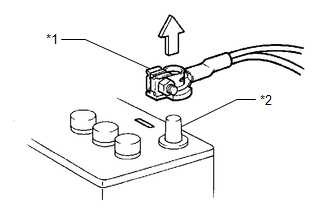
|
*1 |
Cable |
|
*2 |
Negative (-) auxiliary battery Terminal |
NOTICE:
- Certain systems need to be initialized after disconnecting and reconnecting the cable to the negative (-) auxiliary battery terminal.
- Before starting the hybrid system, make sure that the ground point is installed to the body with the bolts.
- After the power switch is turned off, the radio and display receiver assembly records various types of memory and settings. As a result, after turning the power switch off, make sure to wait at least 85 seconds before disconnecting the cable from the negative (-) auxiliary battery terminal. (for Audio and Visual System)
- After the power switch is turned off, the radio and display receiver assembly records various types of memory and settings. As a result, after turning the power switch off, make sure to wait at least 85 seconds before disconnecting the cable from the negative (-) battery terminal. (for Navigation System)
(a) DISCONNECTING AND RECONNECTING CABLE TO NEGATIVE (-) AUXILIARY BATTERY TERMINAL
(1) Before performing work on electronic components, disconnect the cable from the negative (-) auxiliary battery terminal to prevent damage to the electrical system or components.
(2) When disconnecting the cable, turn the power switch and headlight switch off and loosen the cable nut completely. Perform these operations without twisting or prying the cable. Then disconnect the cable.
(3) Clock settings, radio settings, audio system memory, DTCs and other data will be cleared when the cable is disconnected from the negative (-) auxiliary battery terminal. Write down any necessary data before disconnecting the cable.
(b) HANDLING OF ELECTRONIC PARTS
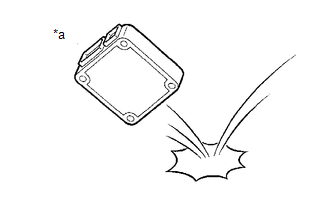
|
*a |
Incorrect |
(1) Do not open the cover or case of the ECU unless absolutely necessary. If the IC terminals are touched, the IC may be rendered inoperative by static electricity.
(2) Do not pull on the wires when disconnecting electronic connectors. Pull on the connector itself.
(3) Do not drop electronic components, such as sensors or relays. If they are dropped on a hard surface, they should be replaced.
(4) When cleaning the engine components with steam, protect the electronic components, air filter and emission-related components from water.
(5) Never use an impact wrench to remove or install temperature switches or temperature sensors.
(6) When measuring the resistance between terminals of a wire connector, insert the tester probe carefully to prevent the terminals from bending.
REMOVAL AND INSTALLATION OF FUEL CONTROL PARTS
(a) PLACE FOR REMOVING AND INSTALLING FUEL SYSTEM PARTS
(1) Work in a location with good air ventilation that does not have welders, grinders, drills, electric motors, stoves, or any other ignition sources nearby.
(2) Never work in a pit or near a pit as fuel vapors will collect there.
(b) REMOVING AND INSTALLING FUEL SYSTEM PARTS
(1) Prepare a fire extinguisher before starting work.
(2) To prevent static electricity, install a ground wire between the fuel changer and vehicle, and do not spray the surrounding area with water. Be careful when performing work in this area, as the floor surface will become slippery. Do not clean up gasoline spills with water, as this may cause the gasoline to spread, and possibly create a fire hazard.
(3) Avoid using electric motors, work lights and other electric equipment that can cause sparks or high temperatures.
(4) Avoid using iron hammers as they may create sparks.
(5) Dispose of fuel-contaminated cloth separately using a fire resistant container.
REMOVAL AND INSTALLATION OF ENGINE INTAKE PARTS
(a) If any metal particles enter intake system parts, they may damage the engine.
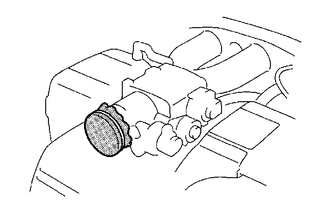
(b) When removing and installing intake system parts, cover the openings of the removed parts and engine openings. Use adhesive tape or other suitable materials.
(c) When installing intake system parts, check that no metal particles have entered the engine or installed parts.
HANDLING OF HOSE CLAMPS

|
*1 |
Clamp Track |
|
*2 |
Spring Type Clamp |
(a) Before removing a hose, check the clamp position so that it can be reinstalled in the same position.
(b) Replace any deformed or dented clamps with new ones.
(c) When reusing a hose, attach the clamp on the clamp track portion of the hose.
(d) For a spring type clamp, it may be necessary to spread the tabs slightly after installation by pushing them in the direction of the arrows as shown in the illustration.
FOR VEHICLES EQUIPPED WITH MOBILE COMMUNICATION SYSTEMS
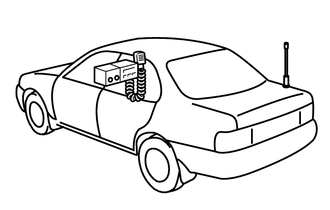
(a) Install the antenna as far away from the ECU and sensors of the vehicle electronic systems as possible.
(b) Install the antenna and feeder at least 20 cm (7.87 in.) away from the ECUs and sensors of the vehicle electronic systems. For details about ECU and sensor locations, refer to the section on the applicable components.
(c) Keep the antenna and feeder separate from other wiring as much as possible. This will prevent signals sent from the communication equipment from affecting vehicle equipment and vice versa.
(d) Check that the antenna and feeder are correctly adjusted.
(e) Do not install a high-powered mobile communication system.
HEADLIGHT INSPECTION OR MAINTENANCE
(a) When the headlights are illuminated, do not cover the headlights for 3 minutes or more.

|
*a |
Illumination for 3 minutes or more prohibited if covered |
NOTICE:
As the headlight outer lens is made of resin, the resulting heat created when covering the headlight for an extended period of time may deform the headlight.
FOR ELECTRIC PARKING BRAKE SYSTEM
(a) Precautions when working on vehicle.
(1) When tilting the vehicle to perform work after parking the vehicle on a level surface, the braking force may not be sufficient. Make sure to pull the electric parking brake switch (electric parking brake switch assembly) to the lock side 2 times (2 lock operations).
HINT:
- The electric parking brake system determines the amount of force used to operate the parking brake according to the tilt angle detected by the deceleration sensor (airbag sensor assembly).
- When the parking brake indicator (red) is illuminated after the electric parking brake switch (electric parking brake switch assembly) has been pulled to the lock side, the maximum amount of braking force is applied if the electric parking brake switch (electric parking brake switch assembly) is pulled to the lock side one more time.
(2) Parking Brake Forced Release Method
FOR VEHICLES EQUIPPED WITH TRACTION CONTROL (TRAC) AND VEHICLE STABILITY CONTROL (VSC) SYSTEMS
(a) NOTICES FOR WHEN TESTING WITH DRUM TESTER
(1) When testing with a 2-wheel drum tester such as a speedometer tester, a combination speedometer and brake tester, chassis dynamometer or when jacking up and turning the front wheels, perform the following procedure to enter inspection mode and disable the TRAC and VSC systems.
NOTICE:
- If the vehicle is tested in normal mode on the tester, TRAC and VSC operation may cause the vehicle to jump off of the tester.
- Check that "CDY-2E" is displayed on the multi-information display.
- Secure the vehicle with lock chains for safety.
- Make sure to cancel inspection mode after completing a check using a 2-wheel drum tester.
- After performing a check, never drive the vehicle without canceling inspection mode.
HINT:
- During inspection mode, the TRAC and VSC systems are disabled and the TRAC OFF message is displayed on the multi-information display and VSC OFF indicator light are illuminated.
- Inspection mode is canceled when the power switch is turned off. As a result, if it is necessary to perform an inspection after the power switch has been turned off, perform the procedure again to re-enter inspection mode.
(b) NOTICES FOR VSC RELATED PROCEDURES
(1) For VSC related parts, adjustments are required after removal and installation. Therefore, perform removal and installation only when necessary.
(2) When performing VSC related procedures, be sure to strictly follow the preparation and completion procedures.
(3) When performing removal and installation or replacement of VSC related parts, first disconnect the cable from the negative (-) auxiliary battery terminal.
WHEN INSPECTING VEHICLE
NOTICE:
When operating the vehicle in inspection mode for an operation such as a speedometer test, a DTC may be stored. Therefore, if a warning light illuminates or warning message is displayed, after canceling inspection mode, check for DTCs using the Techstream and clear the DTCs.
(a) VEHICLE CONDITIONS
(1) Before activating inspection mode, turn the air conditioning off, start the hybrid system with the shift lever in P, and check that the engine stops within several seconds after starting (engine warm up check).
(2) Activate the appropriate inspection mode and inspect the vehicle.
HINT:
Different types of inspection mode are available. One is CDY-2E (maintenance mode), and the other is CDY-2 (certification mode). The following table indicates the mode appropriate for each test item.
|
Test Item |
Mode |
|---|---|
|
Vehicle straight traveling test (side slip inspection) |
CDY-2E (maintenance mode) or normal mode |
|
Braking force test |
Normal mode |
|
Speedometer test |
CDY-2E (maintenance mode) |
|
Exhaust gas test (idling) |
CDY-2E (maintenance mode) |
|
Headlight test |
CDY-2E (maintenance mode) or normal mode |
(3) Cancel inspection mode immediately after completing the inspection.
NOTICE:
Driving the vehicle without canceling inspection mode may damage the hybrid transaxle.
(b) WHEN USING A BRAKE TESTER
NOTICE:
- A high-speed type brake tester cannot be used.
- The vehicle speed should be less than 0.5 km/h (0.3 mph).
- Follow all usage and safety procedures in the operator's manual for the brake tester.
(1) Place the wheels to be tested (front or rear) onto the rollers.
(2) Start the hybrid system to allow normal brake booster operation.
(3) Move the shift lever to N.
(4) Operate the brakes to perform the test.
(c) WHEN USING A SPEEDOMETER TESTER
CAUTION:
Be sure to perform the test in CDY-2E (maintenance mode).
NOTICE:
Do not perform rapid starting or quick acceleration on a speedometer tester. If rapid starting or quick acceleration is performed on a speedometer tester, damage may occur to the hybrid transaxle.
(1) Depress the accelerator pedal slowly and gradually accelerate the vehicle, then take a measurement.
(2) After the measurement, use the brakes to gradually decelerate the vehicle.
(d) WHEN USING A CHASSIS DYNAMOMETER
CAUTION:
Be sure to perform the test in CDY-2E (maintenance mode).
NOTICE:
Sudden acceleration or deceleration of the vehicle on a chassis dynamometer under minimal load may damage the hybrid transaxle.
(1) Always set an appropriate load before starting the test.
(e) WHEN USING AN ON-VEHICLE BALANCER
CAUTION:
- Be sure to perform the test in CDY-2E (maintenance mode).
- Make sure that no one is standing in-line with the spinning wheels.
NOTICE:
- Start the hybrid system and then increase the vehicle speed gradually with the shift lever in D.
- Do not accelerate or decelerate suddenly.
- Deceleration should be done by braking gradually.
- Measurement should be done quickly.
- Confirm that the vehicle is securely immobilized.
- Follow all usage and safety procedures in the operator's manual for the wheel balancer.
(1) Raise the vehicle until all 4 wheels are off the ground.
(2) Support the vehicle with safety stands at an appropriate height. Make sure that the vehicle does not lean in any direction, and that the tires are completely clear of the floor.
(3) Place the vibration pick-up unit into position for the wheel to be measured*.
HINT:
*: Different on-vehicle wheel balancers have different requirements for mounting the vibration pick-up unit(s). Refer to the operator's manual for the wheel balancer to confirm requirements for use.
(4) Release the parking brake.
(5) Check that no dragging force exists when turning each wheel by hand.
(6) Put the wheel balancer in position.
(7) Wheel balance measurement should be done by using both the hybrid system and the wheel balancer drive roller to spin the wheels.
PRECAUTIONS FOR TOWING FRONT WHEEL DRIVE VEHICLES
(a) Use one of the following methods to tow the vehicle.
(b) If the vehicle has trouble with the chassis or drivetrain, use method 1 (flatbed truck).
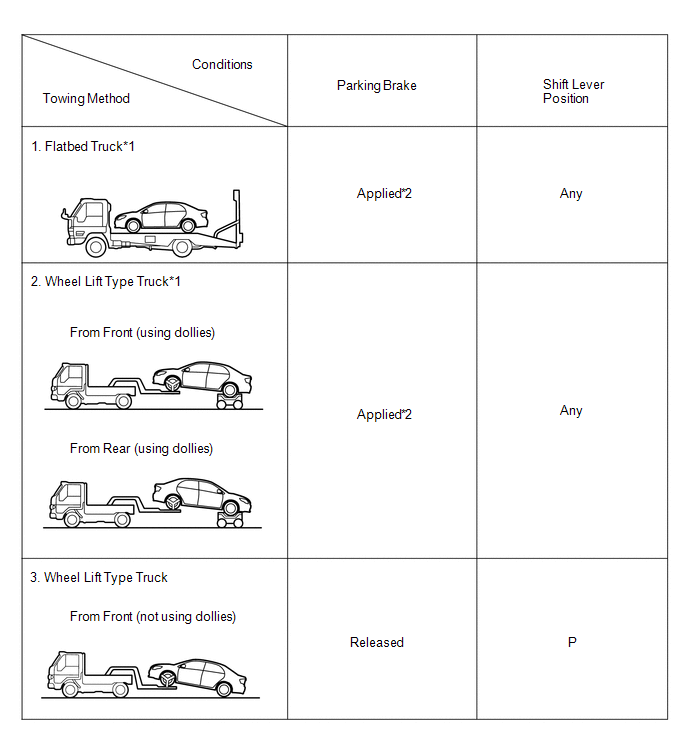
NOTICE:
- Do not use any towing method other than those shown above.
- *1: If the vehicle is tilted after parking on a level surface, the braking force may be insufficient as the electric parking brake determines how much braking force to apply by automatically detecting the slope of the road.
HINT:
*2: When the electric parking brake switch is pulled 2 times (2 lock operations), the system uses the maximum amount of braking force.
(c) If a tow truck is not available, in an emergency the vehicle may be temporarily towed using a cable or chain secured to the emergency towing eyelet(s). This should only be attempted on hard surfaced roads for as short of a distance as possible and at a vehicle speed of 30 km/h (18 mph) or less.
A driver must be in the vehicle to steer and operate the brakes. The vehicle's wheels, drivetrain, axles, steering and brakes must be in good condition.
NOTICE:
If the towing speed exceeds the above limits, or if the vehicle is towed for a long distance or in a backward direction with the front wheels on the ground, the drivetrain may be damaged.
(1) Emergency towing procedure
- Turn the power switch on (IG).
- Depress the brake pedal and move the shift lever to N.
- Release the parking brake.
- Release the brake pedal slowly.
NOTICE:
- Use extreme caution when towing the vehicle. Avoid sudden starts or erratic driving maneuvers which place excessive stress on the emergency towing eyelet and the cables or chains.
- If the hybrid system is off, the power assist for the brakes and steering will not function, making steering and braking more difficult.
- Do not turn off the power switch. Turning off the power switch may result in engagement of the steering lock, resulting in a hazardous situation or accident.
(d) The towing methods shown below are dangerous and can damage the vehicle, so do not use them.

(1) Do not tow the vehicle facing rearward with the front wheels on the ground.
NOTICE:
- If the vehicle is towed facing rearward with the front wheels on the ground, the drivetrain may overheat and be damaged.
- In addition, if the vehicle is equipped with a VSC system, the system may apply the brakes to the rotating wheels.
(2) Do not use a sling-type towing method either from the front or rear.
NOTICE:
If a sling-type tow truck is used, damage may occur to the vehicle body.
FOR VEHICLES EQUIPPED WITH CATALYTIC CONVERTER
CAUTION:
If a large amount of unburned gasoline or gasoline vapors flow into the converter, it may cause converter overheating and create a fire hazard. To prevent this, observe the following precautions:
(a) Use only unleaded gasoline.
(b) Avoid performing unnecessary spark tests.
(1) Perform a spark test only when absolutely necessary. Perform this test as rapidly as possible.
(2) While testing, never race the engine unless instructed.
(c) Avoid a prolonged engine compression measurement. Engine compression measurements must be performed as rapidly as possible.
(d) Do not run the engine when the fuel tank is nearly empty. This may cause the engine to misfire and create an extra load on the converter.
|
|
|